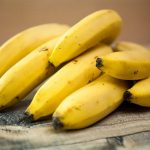 Scholars of Renaissance literature have long noted that nowhere in Shakespeare’s comedies does a character slip and fall on a banana peel. This striking absence of fruit-slapstick is due to the fact that bananas, though they were described by travel writers during Shakespeare’s life, were not commonly imported into England until much later. In fact, even if the young Shakespeare had encountered a banana in a London market, he likely would have called it a muse rather than a banana. The fruit had acquired the name muse by 1578 not because it was a source of poetic inspiration but because the Arabic word for banana—mauz—managed to get itself introduced into English before its rival banana did. However, when banana did enter English in 1597, it quickly became the standard name: by 1602, muse, as a fruit name, was obsolete. The word banana also has a connection to Arabic, though it is one based on a misunderstanding. When Spanish and Portuguese traders travelled to the Congo in Africa in 1563, they mistook the fruit’s African name for an unrelated Arabic word: banan, meaning finger. The mix-up was triggered, no doubt, by the resemblance of a banana to a human finger.
Scholars of Renaissance literature have long noted that nowhere in Shakespeare’s comedies does a character slip and fall on a banana peel. This striking absence of fruit-slapstick is due to the fact that bananas, though they were described by travel writers during Shakespeare’s life, were not commonly imported into England until much later. In fact, even if the young Shakespeare had encountered a banana in a London market, he likely would have called it a muse rather than a banana. The fruit had acquired the name muse by 1578 not because it was a source of poetic inspiration but because the Arabic word for banana—mauz—managed to get itself introduced into English before its rival banana did. However, when banana did enter English in 1597, it quickly became the standard name: by 1602, muse, as a fruit name, was obsolete. The word banana also has a connection to Arabic, though it is one based on a misunderstanding. When Spanish and Portuguese traders travelled to the Congo in Africa in 1563, they mistook the fruit’s African name for an unrelated Arabic word: banan, meaning finger. The mix-up was triggered, no doubt, by the resemblance of a banana to a human finger.
The fruit of a tropical tree comes in two primary variants – the Jamaica or Plantain Banana, characterized by its elongated shape, sizeable dimensions, creamy-colored flesh, and somewhat unremarkable taste, and the Canary or Dwarf Banana, which is relatively smaller and shorter, with flesh that boasts a rosy hue and a more aromatic flavor profile.
